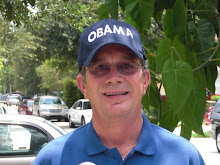

 Above at top: Judy Fentress-Williams, Ph.D
Above at top: Judy Fentress-Williams, Ph.D Above center:Absalom Jones Window at St. George's Episcopal Church, Dayton, OH
Above bottom:Painting of the Rev. Absalom Jones, first African-American Priest of the Episcopal Church
***************************************
***************************************
What a day it was! We were deeply moved by the morning service with guest speaker, Dr. Judy Fentress-Williams. Dr. Fentress-Williamsis Associate Orofessor of Old Testament Studies at Virginia Theological Seminary. Dr. Judy received her Ph.D in Religious Studies from Yale University in 1999. Prior to that, she received her M.Div. from Yale Divinity School. She is a researcher, publisher and writer and all around warm and wonderful person.
We also had quite a south Florida history lesson. Mrs. Ineria Hadley Hudnell has been a collector of African American historical events and the fellowship hall was turned into a remarkable history museum.
Throughout the day's events, Absalom Jones was mentioned a lot. In the Episcopal Church we have a feast day in his honor, Feb. 13th.
After lunch, (catered by Too-Jays), we went back to the sanctuary at St. Pauls Episcopal Church) where Dr. Judy gave a wonderful talk on the lamentations of slaves in America and the role of the Psalms and the early African American spirituals. We did a lot of singing during the discussion.
I was totally blown away when Dr. Judy presented me with a Barack Obama sticker written in Hebrew and I learned that the Hebrew translation of Barack is "Blessed." In turn, I gave her one of my "Time for Change" Obama buttons.
ABSALOM JONES
The years between 1740 and 1764 in America are known as the Great Awakening, a period of sweeping revival, with an emphasis on personal aspects of Christianity, “new birth” and corresponding sanctity of life. The effects were far reaching, and included a significant increase in the status of, and educational opportunities for black Americans, especially in the parishes most receptive to the movement.
Missionaries came from England to work with blacks, and by 1765, Anglican schools for blacks were open in four colonies. These changes laid the groundwork for black advances after the Revolutionary War, when many began to act on the ideals that it represented, including finding their voice in the Church. A total of 16 blacks were ordained in the Episcopal Church prior to the Civil War, and many Episcopalians, including blacks became missionaries to Liberia.
Absalom Jones was born a house slave in Delaware, in 1746. He taught himself to read using a New Testament, and later attended night school. At 20, he married and bought his wife’s freedom; at 38, he was able to purchase his own. While living in Philadelphia, he became a lay minister for black members of St. George’s Methodist Episcopal Church.
When black membership soared, the vestry was taken by surprise and attempted to segregate the congregation. The blacks refused and walked out, forming the Free African Society, with Jones as an overseer. The Society collected money from members in order to help the needy, and was the first organized African American society. In 1794, the Society built a church that was admitted into the Episcopal Diocese of Pennsylvania as St. Thomas African Episcopal Church.
Within the year, membership grew to more than 500. Soon Jones was ordained as a deacon, and finally a priest (1804), becoming the first African American to be ordained by a hierarchical denomination. Jones was a gifted evangelist and earnest preacher. These traits, along with his constant visiting and mild manner, endeared him to the community.
Though he was never consecrated, he became known as “the Black Bishop of the Episcopal Church.”
Jones’ history or, and denunciation of, slavery are remembered in this window by the chains and the cameo of a house slave learning gracefulness with a book on her head. The American flag symbolizes Jones’ eventual freedom, and his remarkable string of American firsts: his black society, parish, and ordination



No comments:
Post a Comment